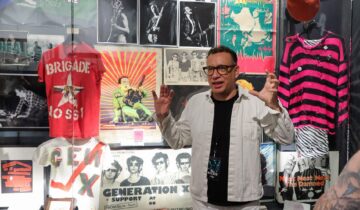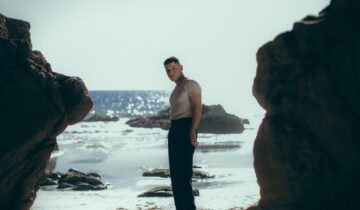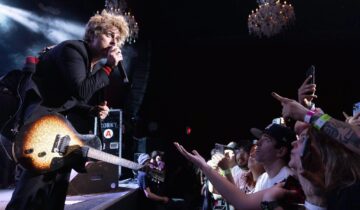 The new SFJAZZ Center in San Francisco, a swank 700-seat concert hall with stadium seating and tall ceilings, begs the question: is it more important that live jazz be intimate or sound good?
The new SFJAZZ Center in San Francisco, a swank 700-seat concert hall with stadium seating and tall ceilings, begs the question: is it more important that live jazz be intimate or sound good?
The San Francisco nonprofit group SFJAZZ, which has been hosting jazz events at various venues in the city since the 80s, and in January opened its permanent, 35,000 square-foot, three-story home, says live jazz can and should be both. While their new venue doesn’t offer the low-ceilinged, elbow-to-elbow proximity of a small jazz bar, it does offer pristine sound and does get you relatively close enough to the stage to see facial expressions, hand movements, and the sweaty brows of the performers, depending on where you sit.
White oak walls line the auditorium, which has three seating sections that surround the stage to the front and a row of seating behind the stage. The corners of the upper rows provide space to stand and sip cocktails, with tall tables like you might find in a bar. A large movie screen along the back wall displays visuals and lighting as musicians play. A 24-foot wide steel acoustic canopy above the stage is designed to scatter sound coming off the stage throughout the room. Smaller speakers are used to provide strong, directional mid- and low-frequency sounds.
Large windows along the front of the $64 million building allow passersby easy viewing of music rehearsals and live performances, tempting them to step inside and grab a cocktail or eat in the street-level café and peruse the venue’s calendar of events. The neighborhood lends itself to foot traffic: it’s loaded with restaurants, bars and cafes, has easy access to public transportation, and is adjacent to the city’s performing arts district.
Concert halls worldwide incorporate jazz into their programming, but auditoriums devoted exclusively to jazz, such as Frederick P. Rose Hall at Lincoln Center in New York City, are rare. More common are bars and clubs devoted to jazz, like Ronnie Scott’s in London or the Village Vanguard in New York that seat roughly 200 people.
But the SFJAZZ Center, with its digital labs, pristine acoustics, and Leadership in Energy and Environmental Design (LEED) certification, isn’t competing with these smaller spaces. Its aim is to turn the downward trend in jazz listenership upward, by bringing in local school children, parents, and music fans and getting involved in music education and classes and seminars on the global jazz diaspora. Local high school jazz groups rehearse and perform here, which may lure young listeners or aspiring young musicians in. A 2011 Jazz Audiences Initiative study confirmed that while a large majority of jazz show attendees fall into the 55 to 64 age range, SFJAZZ had the largest percentage of 18-35 year-old fans than other venues included in the study.
Since its beginnings as a weekend jazz festival, the SFJAZZ organization has now grown to a staff of 50, has a 30-member board of trustees, and presents more than 100 concerts annually for its 100,000-plus fans. Its designation as a non-profit helps achieve their bottom line with grants, endowments, and institutional giving from people who, according to center director Randall Kline, “simply love jazz music.” Kline says funds were not difficult to raise but would not discuss details about donors or go into specifics about their “The World is Listening” fund campaign, in which artists like McCoy Tyner, Esperanza Spaulding, and Wynton Marsalis endorsed the center.
Compared to 200-capacity venues, the SFJAZZ center simply is not as intimate, but Kline maintains that he as built a venue that provides an “optimal listening environment” for people who love the music. “A lot of the great jazz music I’ve heard has been in much funkier places, what I call ‘found spaces,'” Kline said. “But we’re not just a jazz club, we’re a 21st Century cultural institution.”
Current members of the center’s in-house band the SFJAZZ Collective, who hail not from San Francisco but from places like Puerto Rico, Israel, and Philadelphia, recently played a four-night run of music composed by pianist Chick Corea and original compositions inspired by Corea. Despite the trombone player’s use of sound-augmenting electronic pedals and a laptop, the performance felt more retro than contemporary, mainly because of their devotion not just to Corea’s late-60s and 70s compositions but in mimicking that sound in their own work. The performance was high-energy but so precise that it felt stiff at times. The sound quality on the first of those four nights, a sold-out show, was stellar. Walking around the venue, there didn’t seem to be any bad vantage points or seats stuck behind poles. The band received a standing ovation at the end of the show.
Kline says the center has an “eclectic” vision for jazz; an ambiguous term that makes more sense when you look at the venue’s calendar: pianist Jason Moran invited Bay Area skateboarders to skate a half-pipe installed in front of the stage just for his early May performances. Violinist Regina Carter will perform this month alongside the Carolina Chocolate Drops, an all-black group that plays old-time Appalachian music typically associated with white musicians.
This is a creative roster that feels a bit more adventurous but not giant leaps away from Jazz at Lincoln Center, arguably SFJAZZ’s most well-known peer. Although jazz is a music genre often staunchly conservative about defining itself, eclectic jazz programming will likely benefit the San Francisco center, said Greg Scholl, executive director of Jazz at Lincoln Center. “We all need to conceive of ourselves as working together to help jazz artists, acting as jazz messengers and jazz ambassadors collecting audiences and building audiences. There is a very large global audience for jazz, but very diffuse. We need to pull them together.”
At a time when jazz, or, “the J word,” often carries negative connotations about its aging listeners, its lack of well-known living heroes, and ties to a bygone era, SFJAZZ promises a breath of fresh air and ambition to reverse these trends. And it clearly has wealthy benefactors perfectly willing to aid the process. Let’s hope the center casts a wide net and books not just well-known, well-established artists trying new things, and high school students showing what they’ve learned, but up-and-coming artists that members maybe haven’t yet heard of; musicians with acoustic instruments mashing up jazz theories in ways that might otherwise go unnoticed for years.
By doing this, fans might have the chance to celebrate a wider range of living jazz artists and watch them grow, rather than collecting their library of sounds after they’re gone and reflecting on a career from yesterday. This, combined with everything else, would make them the cultural institution they aim to be.
photo: vacant building across the street from SFJAZZ Center. photo by Gary Moskowitz



